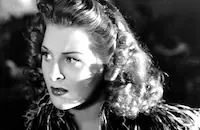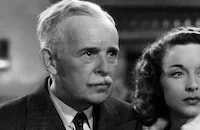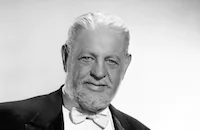Hold That Ghost

Brief Synopsis
Cast & Crew
Arthur Lubin
Bud Abbott
Lou Costello
Richard Carlson
Joan Davis
Mischa Auer
Film Details
Technical Specs

Synopsis
The Andrews Sisters and Ted Lewis and His Orchestra are performing at the "Chez Glamour" nightclub, where Chuck Murray and Ferdinand "Ferdie" Jones are working as relief waiters. The two bumblers, however, are much more interested in playing dice than serving tables. Gangster Sidney "Moose" Matson arrives at the nightclub with his lawyer, Bannister, who tells him that "two-bit hood" Charlie Smith wants half the money from Moose's latest hold-up or he will go to the district attorney. Moose states that he doesn't plan to pay Charlie anything, as only he knows where the stolen money is. Meanwhile, Chuck and Ferdie are fired by the head waiter, Gregory, when they are caught eating their patrons' food. After they return to working at a gas station, Chuck and Ferdie find themselves servicing Moose's car when the police arrive, and the two are trapped inside the gangster's car during a high-speed shootout. Moose is shot and killed, and Chuck and Ferdie learn that they are the benefactors of his will, which gives his estate to whomever he is with when he dies. During a meeting with Bannister, they are told that they have inherited an old tavern. The next day, they travel by bus to the tavern, along with Charlie Smith, Jackson, a physician, Norma Lind and radio performer Camille Brewster. Once there, the bus driver announces that the weather is too bad to continue the trip, so the group becomes Chuck and Ferdie's first guests. Only when the bus driver takes off with their luggage, however, do they realize that they are stranded at the tavern. Examining the grounds, the group discovers hidden rooms and comes to realize that Moose used the tavern as a speakeasy during Prohibition. When Charlie goes into the basement, he is strangled to death by an unknown hand. Ferdie becomes convinced that the tavern is haunted, as strange things continually happen to him when he is left alone. Unable to find Charlie, the group decides to go to bed. In Moose's old room, Chuck and Ferdie discover Charlie's body, but when the police arrive unannounced, the body disappears. Each time Ferdie tries to go to bed, his room changes into a gambling parlor, but then it changes back to a bedroom when Chuck enters. Downstairs, Norma finds Jackson testing the tavern's water, and the two begin to feel a mutual attraction. After being chased by what appears to be a ghost, Ferdie and Camille sit together downstairs, where a floating candle causes Ferdie much concern. Chuck and Camille, meanwhile, try to figure out where Moose's money may be. As he had said that he kept it "in his head," Ferdie suggests the money is in the moose head on the wall, an idea which the others ridicule. Sticking his hand in the moose's mouth, however, Ferdie finds the money, much to Chuck and Camille's disbelief. The police finally reemerge, but reveal themselves to be members of Moose's gang who have been looking for his money for fifteen years. The gangsters chase the group throughout the house, with Ferdie knocking them out one by one with a bag of money. Alerted by the sound of a police siren, the gangsters scamper out of the tavern, unaware that the "siren" was actually Ferdie. Afterward, the group divides the money, and Chuck and Ferdie consider opening their own gas station. Jackson, however, tells them that they should turn the tavern into a health spa, as the water has great therapeutic values. Later, on opening night of the spa, Jackson and Norma arrive fresh from their honeymoon, and Ferdie tells them that he and Camille had a "runaway wedding": she wanted to get married, so he ran away. Ferdie works the cash register, but when Chuck checks it, he finds it nearly empty, then discovers all the money hidden in Ferdie's tuxedo.

Director
Arthur Lubin
Cast

Bud Abbott

Lou Costello

Richard Carlson

Joan Davis

Mischa Auer

Evelyn Ankers
Marc Lawrence

Shemp Howard

Russell Hicks

William Davidson
Ted Lewis

The Andrews Sisters
Milton Parsons
Frank Penny
Edgar Dearing
Don Terry
Edward Pawley

Nestor Paiva
Spencer Charters

Paul Fix

Howard Hickman
Mrs. Gardner Crane
Harry Hayden
William Forrest
Charles B. Smith
Paul Newlan
Joe La Cava
Stanley Smith

Thurston Hall
Hans Herbert
Crew
Harold Adamson
Elwood Bredell
Bernard B. Brown
Philip Cahn
Nick Castle
Dave Dreyer
William Fox
R. A. Gausman
John Grant
Mort Greene
Joan Hathaway
Al Jolson
Burt Kelly
Mario Lago
Robert Lees
Robert Lees
Ted Lewis
Harold H. Macarthur
Bill Munro
Jack Otterson
Fred Rinaldo
Fred Rinaldo
Roberto Roberti
Billy Rose
H. J. Salter
Louis C. Singer
Andrew B. Sterling
Johann Strauss Ii
Glenn Tryon
Gilbert J. Valle
Vera West

Film Details
Technical Specs

Articles
The Best of Abbott and Costello, Volume One
So why the popularity? Because Abbott & Costello had a type of goofy charm that comes through no matter what the circumstances and at their best were undeniable masters of comic dialogues. Good evidence can be found in the new DVD set The Best of Bud Abbott and Lou Costello, Volume 1 which contains their first eight feature films from 1940 to 1942 (the only one missing from that period is Rio Rita, presumably to be included in the next set). Better yet the entire package has a list price of $24.98 and despite such a budget price the films show crisp remastering and respect for detail. There are also some good though brief production notes included. The one drawback is that the discs and packaging don't tell you which side of which disc has a particular film; that information is only given on an insert.
In their first feature, One Night in the Tropics the duo are second-billed as a test for their screen abilities. They do manage to get off a couple of striking routines but it's the followup, Buck Privates (1941), that really showed what they could do. This is one of their best efforts, with the two unintentionally enlisting in the Army and the mayhem that results from that encounter; just imagine Lou trying to follow a drill sergeant's orders! With U.S. participation in the war looming, Abbott & Costello made two more service comedies that same year as morale boosters. In the Navy and Keep `Em Flying both follow the Buck Privates pattern though with enough fast and and snappy bits to keep things lively. Keep `Em Flying is particularly helped by the presence of ex-vaudeville comic/singer Martha Raye (who ironically enough was in real life afraid of flying).
Other Abbott & Costello films tend to present a high concept situation where the boys are let loose. Thus you'll find them in a haunted house (Hold That Ghost), a dude ranch (Ride `Em Cowboy), the South Seas (Pardon My Sarong) and a murder mystery (Who Done It?). None are classics even by A&C standards but generally work on sheer momentum. Hold That Ghost showcases a stream of sight gags (Lou's reactions to a mysteriously moving candle), twisting patter, peculiar characters and even songs courtesy of the Andrews Sisters. It's never more than the sum of its parts but most comedies don't even have parts that good. Still, an example of A&C at their weakest is Ride `Em Cowboy, one reason being because the team doesn't appear as often in it. Much of the time is instead given over to a tedious plot and lame singers, with the notable exception of a 25-year-old Ella Fitzgerald girlishly romping through her breakout hit "A-Tisket A-Tasket" (though unfortunately backed by a Hollywood orchestra instead of a jazz band).
Despite that film, it's hard to go wrong with a set at such a low price. Abbott & Costello won't appear on any future Sight and Sound polls but neither will they be forgotten.
. To order The Best of Abbott and Costello, Vol. 1, go to TCM Shopping.
by Lang Thompson

The Best of Abbott and Costello, Volume One
Quotes
I called 42 Oh, Chucks and you didn't come in.- Ferdie
I came in as soon as you hollered "Oh, Chuck!"- Chuck
From now on, don't wait for me to say "Oh, Chuck!" Get in here on the "Oh!"- Ferdie
You boys ready to leave?- Camille
I was ready to leave when he put the key in the front door to come in!- Ferdie
Look, from now on, keep one eye on that candle, another eye on that one, and with the other eye watch me!- Ferdie
Is everybody happy?!- Ted Lewis
If you see a pair of pants go flyin' through the air, don't grab 'em.- Ferdie
Why not?- Chuck
I'll be in 'em!- Ferdie
Trivia
Original title was "Oh Charlie!"
The Andrews Sisters were brought in after filming wrapped and the final nightclub footage was edited in after the film's completion.
Notes
The working title of this film was Oh, Charlie. The picture was originally scheduled to be Abbott and Costello's second release of 1941, but with the unexpected success of Buck Privates (see entry above), Universal decided in April 1941 to hold back the film and release In the Navy first, as it was also a military comedy with high production values. Hollywood Reporter reported on April 7, 1941 that Universal had decided to upgrade Oh, Charlie with additional sequences featuring the Andrews Sisters and Ted Lewis and His Orchestra. This announcement also stated that one sequence would be based on George Gershwin's "Rhapsody in Blue," but that musical number did not appear in the released film. The additional sequences were shot in mid-May 1941, and actor Mischa Auer was added to the cast. According to Variety, Burt Kelly was the original associate producer on the film, but left the studio to take a similar position at Paramount when the film was in its initial editing stages. For the additional material, Universal assigned Glenn Tryon to replace Kelly as the associate producer.
In June 1941, The film was retitled Hold That Ghost and its release was set for August 1941, following the success of In the Navy. On August 19, 1941, Hollywood Reporter stated that the film had opened to "100% capacity crowds," despite "luke warm reviews." Modern sources claim that after actress Evelyn Ankers' deal with Twentieth-Century Fox collapsed, she signed a seven-year contract with Universal and was then cast in this picture. In a modern interview, director Arthur Lubin stated that he was assigned to Hold That Ghost only after the success of the Buck Privates preview, and that he was paid $5,000 to start directing it the very next day. Modern sources also state that the final budget of this film was $190,000. Modern sources credit Alex Gottlieb as produer and John Rawlins as 2nd unit director for the production and add Janet Shaw (Alderman's girl), Frank Richards (Gunman), Bobby Barber (Waiter), Harry Wilson (Harry), Jeanne Blanche ("Pretty Thing"), and Kay, Kay & Katya (Dancers) to the cast.















